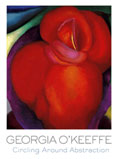
By the mid-1920s, O'Keeffe's reputation as one of the country's most significant artists was secure, as was her ability to live comfortably from the sale of her paintings. Over the next two decades, she continued to broaden her range of subject matter. In addition to her celebrated flower paintings, landscapes of Lake George, and spare still lifes, she went on to paint numerous depictions of the New York skyline, sensitive renderings of the rugged landscape and adobe structures of New Mexico, and haunting canvases featuring floating cattle skulls.
Despite the popularity and commercial success of her more objective paintings, O'Keeffe remained committed to abstraction as a means of communicating her deeply held convictions about her subjects. In 1922 she had argued: "Nothing is less real than realism. Details are confusing. It is only by selection, by elimination, by emphasis that we get at the real meaning of things." It is therefore not surprising that over the next two decades she continued to experiment quietly with abstraction, pushing many of her paintings in this direction, particularly those that focused on subjects drawn from the natural world.

